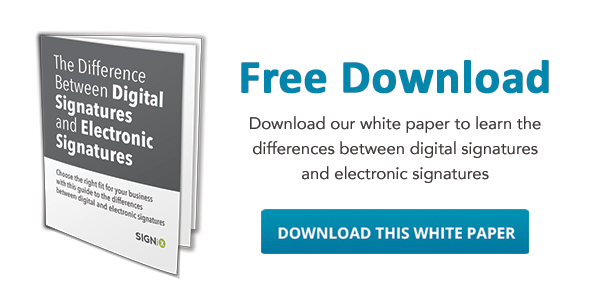So you’re running a business and you’re just dying to start using e-signatures: they’ll make your life easier and your customers happier. Then your customers will tell everyone how amazing you are, your business will take off, and pretty soon you’ll be on the cover of Fortune Magazine!
Whoa now, slow down. You shouldn’t spend a single dollar on e-signatures until you ask these three questions, says John Harris, an e-signature guru and our very own director of product management.
So what are those three questions?
1. How will my documents be protected against tampering?

When you’re dealing with electronic documents, you have to make sure they’re protected against tampering. After all, anyone with a PDF editor can change the terms of a document if they wanted to. You need to be sure that if someone tampers with one of your documents, you can prove the tampering happened.
That’s why some e-signature vendors offer a feature called “tamper evidence.” With tamper evidence, all you have to do is open the document in any free PDF reader. If there’s been tampering, the PDF reader will show you an alert letting you know when the tampering happened and what was changed.
It's also important to make sure the document is secure from tampering not just at the end of the signing process, but during the process too. Some vendors only secure the document at the end of the signing process, which leaves you open to risk. Someone could change the document while in transit between signers or simply claim the document was different when they signed it. If you don’t have the evidence and protection embedded in the document to prove what the document looked like throughout the signing process, you put your documents, and your business, at risk.
SIGNiX adds a tamper-evident seal to the document with each signature and initial applied to the document, meaning you never need worry about this potential risk.
2. What options will I have in proving the identity of my signers?
No matter what documents your business works with, it’s important to know who’s signing, especially when it’s been done remotely. That’s why electronic signature services offer a feature called “identity authentication.” There are several different ways you can prove a signer is who they say they are. Here are some of the common options:
- Email Authentication: With this type of authentication, signers confirm their identity by clicking a link to prove they have access to their email account. This is a low cost option for low-risk transactions.
- Shared Secret Questions: With this type of identity authentication, signers answer a question that you choose when you send the document. This can be based on information you already know, like the last four digits of an account number, the signer’s favorite sports team or the signer’s mother’s maiden name, or other questions that help verify the signer’s identity.
- Mobile Phone Authentication: With this kind of authentication (sometimes called SMS authentication), the e-signature vendor sends your signer a text message with a randomly generated passcode. The signer proves they have access to their cell phone by entering the code to get access to view and sign the document. Our signers really like this method because it’s simple and there are few who go anywhere these days without a mobile phone.
- Knowledge-Based Authentication (KBA): With KBA authentication, signers are asked a set of four questions based on databases of 30 years of public records. This is a highly trusted identity authentication method that pulls information from public health records, town hall records, credit reports and more. Questions are factual, like “What color Toyota Camry did you register in Mississippi in 2002?” or “What county were you born in?”
Not all transactions require the same level of identity authentication, so it’s important that you pick an e-signature vendor with a variety of options to choose from. SIGNiX offers all of these options and more to guarantee a wide set of capabilities to best match your needs.
3. What happens to my signed documents if I decide to switch vendors?
This last question is by far the most important, and it's a subject that many companies overlook. Most of our competitors prove that a document is authentic by tossing a signature image onto a document and then giving you a link back to their website. At first glance this may not seem like a big deal, but it's actually critically important.
If one of your documents is ever challenged in court, you will have to be able to prove the document is authentic. If you use a company that uses a simple link back to their own website to prove documents are legal, you're putting your company at risk. If that company gets acquired, goes out of business or changes their technology, your signed documents can't be authenticated. In fact, if you try to authenticate a document signed with the "other guys" in those situations (or even without an Internet connection), all you'll get is a message saying "404 Error – Web Site Not Found." You can bet that won't stand up in court.
In contrast, we use digital signatures, which are based on international standards and have been trusted in the technology sector for 20 years. Our signatures and their cryptographic data are embedded into the signed document. That means you don't have to be a SIGNiX customer or even be connected to the Internet to prove a document is authentic. You can read the highly-detailed in-document audit trail to find out who signed, when they signed and if the document has been tampered with after signing, and then back that up with our highly detailed transactional audit trail which shows you all of the steps that took place to get the document(s) signed.
This is essential because, as anyone who ever used a floppy disk knows, technology changes at an incredible rate. If you base your business on a specific, proprietary technology rather than published standards, you're putting your business at risk. In fact, we would argue that businesses are safer continuing to use paper processes rather than using a vendor that doesn't embed digital signatures with every signature and initial into your signed documents. Though using paper and wet ink is much more expensive and less efficient than e-signature technology, it is preferable to adopting a technology that puts your company at risk.
If you keep these three considerations in mind, you can be sure you pick an e-signature vendor that you'll be happy with not just today but decades down the road.
%20formatted-1.png?width=2528&height=739&name=SIGNiX%20Logo%20Main%20(white)%20formatted-1.png)

